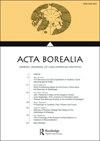Nomadic, ecstatic, magic: Arctic primitivism in Scandinavia around 1900
IF 0.6
4区 社会学
0 HUMANITIES, MULTIDISCIPLINARY
引用次数: 3
Abstract
ABSTRACT The aim of this article is to delineate the term “Arctic primitivism” in an aesthetic context and, by means of three examples from Scandinavian artists whose works were also the subject of ethnological discussions, to give an illuminating impression of Scandinavian Arctic primitivism around 1900. First some conceptual considerations about the combination of Arctic and primitivistic discourse will be presented. Then three examples for the “primal conditions” of an aesthetic conception of Arctic primitivism will be discussed: the nomadic, the ecstatic, and the magical. They serve as counter principles to modern categories such as spatial fixedness, linear chronology, and rational thought. Emilie Demant Hatt’s visual art stands for the nomadic principle; the Swedish cartoonist Ossian Elgström deals with ecstatic states; and the poems of Danish “eskimologist” William Thalbitzer show his fascination with indigenous magical incantations as an alternative to rational thought. All examples illustrate the artists’ interest in an authentic and uncorrupted culture, which they reflect on with awareness of inauthenticity and second-hand acquisition. The effects of duplication, simultaneity, and secundarity arising from the three principles drive a reflective discourse on media through which awareness of the crisis of modernity is sublimated, revealed, or made the subject of artistic exploration.游牧、狂喜、魔幻:1900年前后斯堪的纳维亚半岛的北极原始主义
本文的目的是在美学背景下描述“北极原始主义”一词,并通过三位斯堪的纳维亚艺术家的作品(他们的作品也是民族学讨论的主题)的例子,给出1900年左右斯堪的纳维亚北极原始主义的启发性印象。首先,将提出一些关于北极和原始话语结合的概念性考虑。然后将讨论北极原始主义美学概念的“原始条件”的三个例子:游牧的、狂喜的和神奇的。它们是空间固定性、线性年表和理性思维等现代范畴的反原则。艾米丽·德芒特·哈特的视觉艺术代表了游牧原则;瑞典漫画家Ossian Elgström描写狂喜的状态;丹麦“爱斯基摩学者”威廉·撒比泽尔的诗歌显示了他对土著魔法咒语的迷恋,认为这是理性思维的一种选择。所有的例子都说明了艺术家对真实和廉洁的文化的兴趣,他们用不真实和二手获取的意识来反思。从这三个原则中产生的复制、同时性和次要性的影响推动了媒体上的反思性话语,通过这种话语,对现代性危机的意识被升华、揭示或成为艺术探索的主题。
本文章由计算机程序翻译,如有差异,请以英文原文为准。
求助全文
约1分钟内获得全文
求助全文

 求助内容:
求助内容: 应助结果提醒方式:
应助结果提醒方式:


